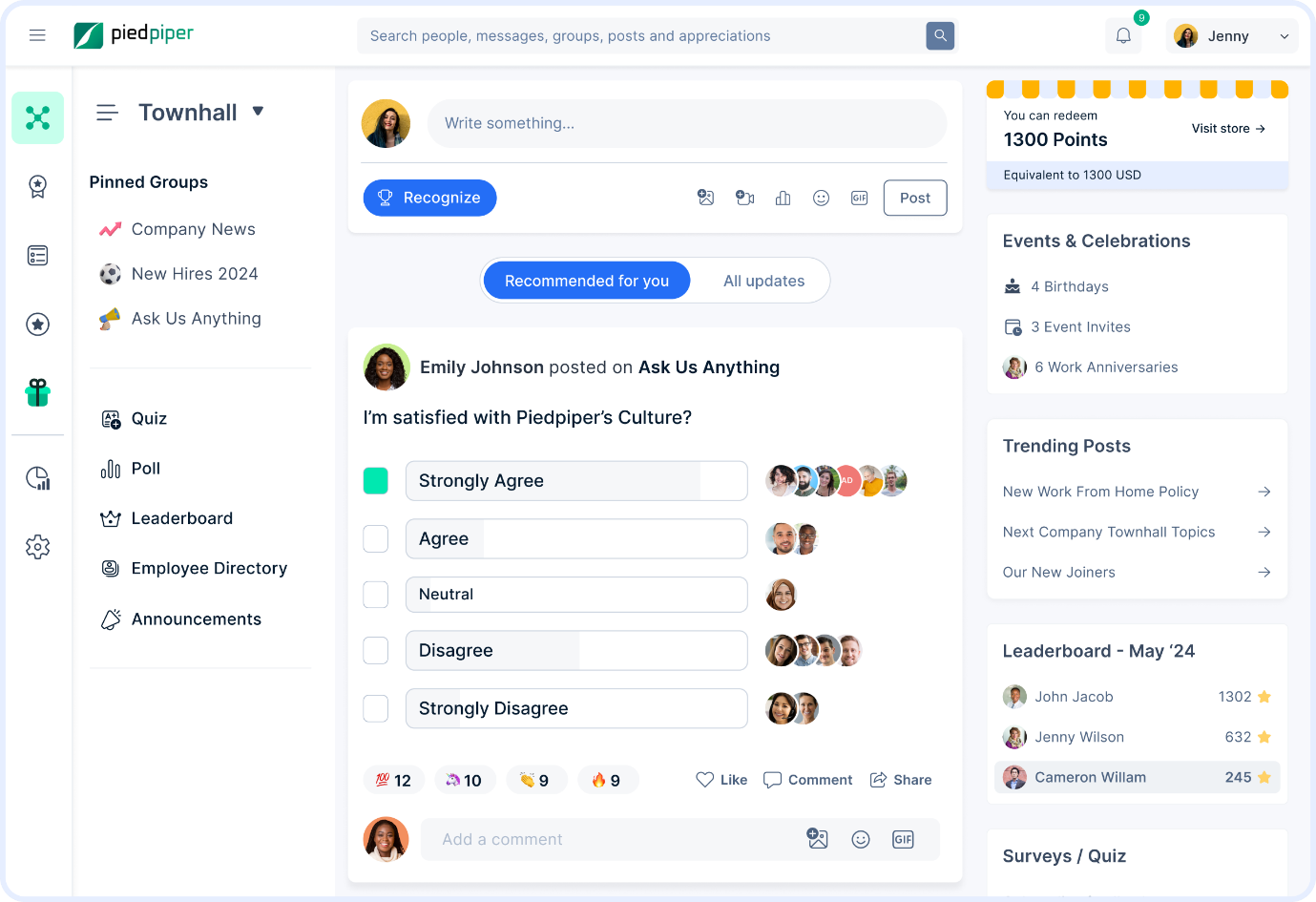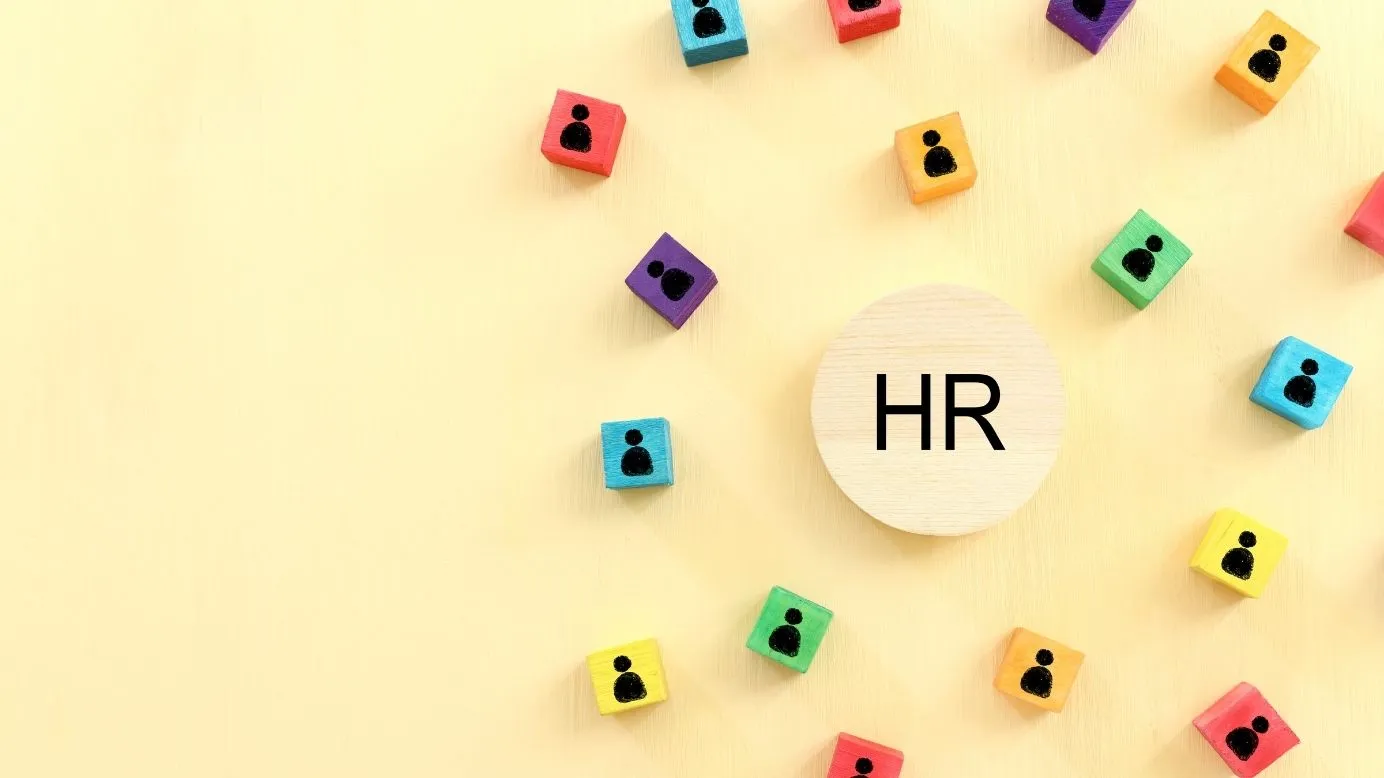The Evolving Role of HR in Engagement: Strategies for a Thriving Workforce
Explore the evolving role of HR in engagement. From hiring and onboarding to recognition and well-being, HR plays a key part in driving a motivated, loyal workforce.
في هذه الصفحة
كان على العديد من المنظمات في جميع أنحاء العالم التكيف مع الوضع الطبيعي الجديد في العام الماضي ، ولم يكن الأمر سهلا على معظمها. فقد الناس وظائفهم، وأجبروا على العمل في ظروف غير آمنة للحفاظ على سقف فوق رؤوسهم، واضطروا إلى الاستمرار في العمل كما لو كان العمل كالمعتاد أثناء التعامل مع الخسائر والمعاناة التي لا يمكن تصورها.
كان HR على رأس كل هذا ، حيث قاد السفينة عبر هذه المياه العكرة. الآن ، يواجهون التحدي الجديد المتمثل في جعل الموظفين يبدأون العمل في المكتب مرة أخرى. مرة أخرى ، الموارد البشرية مسؤولة ليس فقط عن ضمان الحفاظ على مستويات الإنتاجية ولكن أيضا للتأكد من أنها تشارك بشكل هادف في أنشطة المنظمة.
They’re now also the ones who are responsible for hiring the manpower organizations lost in the past year and for streamlining the employee onboarding process and HR’s Role in it.
But before we delve deeper into HR’s Role in maintaining employee engagement and how it’s evolving, let’s talk about employee engagement in hr.
What is employee engagement in human resource management?
In the context of human resource management, employee engagement goes beyond job satisfaction or surface-level happiness. According to Forbes, it’s the emotional commitment an employee has toward their organization’s goals and values. This commitment drives motivation, discretionary effort, and loyalty—key drivers of productivity and retention.
Employee engagement in human resource management is now a strategic pillar that influences every stage of the employee lifecycle—from onboarding and learning to recognition and retention.
According to Forbes, employee engagement is the emotional commitment the employee has to the organization and its goals.
In the article by Kevin Kruse, the CEO of LEADx, employee engagement is not the same thing as employee satisfaction - or even employee happiness.
ما هو دور الموارد البشرية في مشاركة الموظفين؟
HR's Role is to ensure employee engagement throughout the times. Employee engagement itself is a relatively new phenomenon. Before the 1990s, HR was all about employee satisfaction and not much else, and no mind was given to whether the employee cared about their organization or not.
لطالما كان التركيز الرئيسي للموارد البشرية هو الحصول على نتائج من القوى العاملة ، لكن الخبراء يعتقدون الآن أن هذا يحتاج إلى التغيير.
في مقابلة مع مجلة فوربس ، تحدثت ليندسي لاغريد عن حاجة الموارد البشرية إلى اتباع نهج أكثر تركيزا على الموظف في الأمور في المستقبل. لديها هي وفريقها في معهد Limeade أبحاث كبيرة تدعم حقيقة أن الشركات الناجحة هي تلك التي تهتم بموظفيها كأشخاص. وفقا لاغريد نفسها ، "الموارد البشرية هي مهندس تجربة الموظف وتحتاج إلى العمل كمدافع لا يلين عن صوت الموظف للقيادة".
في الوقت الحاضر ، أصبح من الصعب على أصحاب العمل الاحتفاظ بالموظفين الموهوبين. هذا لأن الناس لا يبحثون فقط عن وظيفة مستقرة يمكنهم العمل فيها مدى الحياة بعد الآن.
إنهم يبحثون عن النمو والتحديات ومهنة مجزية ، والأهم من ذلك كله ، أنهم يبحثون عن حياة سعيدة. إذا كانت وظيفتهم في طريق كل هذا ، فقد يفكرون في تغييرات جذرية في حياتهم.
Let’s break down the core areas that define HR and employee engagement in today’s context:
1. Hiring with purpose and cultural alignment
Modern HR teams are no longer just filling open roles—they're curating experiences from day one. By hiring talent that aligns with the company’s purpose and values, HR lays the foundation for long-term engagement.
Recruiting isn't just about skills; it’s about identifying individuals who resonate with the organization's mission and are likely to thrive in its culture.
2. Designing meaningful onboarding experiences
Effective onboarding is one of the first opportunities HR has to engage employees. It's where employees learn not just what to do, but why their work matters.
Human resources professionals must ensure that onboarding is structured to communicate the organization’s vision, showcase leadership accessibility, and encourage early connection with peers—all of which contribute to engagement from the start.
3. Empowering managers to drive engagement
While HR designs the engagement strategy, it's often managers who implement it. That’s why human resources and employee engagement go hand in hand with leadership enablement.
HR needs to equip managers with data, tools, and training to recognize efforts, facilitate meaningful conversations, and foster team cohesion. When managers are supported, they become the frontline champions of engagement.
4. Creating opportunities for growth and purpose
One of the primary reasons employees disengage is a lack of growth. HR plays a vital role in building clear career paths, promoting internal mobility, and offering learning opportunities that align with both business goals and employee aspirations.
Moreover, by connecting day-to-day tasks with organizational impact, HR helps employees see purpose in their work—an essential component of engagement.
5. Measuring and acting on employee feedback
Data-driven HR functions rely on continuous listening. Tools like pulse surveys, engagement assessments, and eNPS scores are key to understanding how employees feel.
The HR role in employee engagement includes analyzing this feedback and driving actionable change. It's not enough to collect data—HR must act on it, close feedback loops, and communicate progress.
6. Recognizing and rewarding contributions
A well-structured recognition and rewards program can significantly boost morale. HR should create frameworks for peer-to-peer recognition, milestone celebrations, and values-based acknowledgments.
Recognition doesn't always have to be monetary. Personalized appreciation, public acknowledgment, and meaningful gestures can go a long way in building trust and boosting engagement.
7. Supporting well-being through holistic initiatives
The lines between work and life have blurred. As a result, human resources employee engagement strategies now include mental health resources, flexible benefits, and wellness programs.
When employees feel supported as individuals—not just workers—they are more likely to stay engaged and productive. HR plays a pivotal role in designing benefits that meet the diverse needs of a multigenerational workforce.
تطور دور الموارد البشرية في مشاركة الموظفين
الموارد البشرية هي ميسر بين العمال والمديرين والقيادة التنفيذية. لذلك تلعب فرق الموارد البشرية دورا مهما في الحفاظ على مشاركة الموظفين.
1. Manager's duty
كان شيء مثل مشاركة الموظفين حاضرا دائما في جميع المؤسسات - فقد أظهر نفسه في الطريقة التي تعامل بها العديد من المديرين مع الشؤون اليومية في الشركة وحول المكتب ، وفي الطريقة التي تأكدوا بها من أن جميع الموظفين سعداء وقاموا بتكوين فريق متماسك يعتمد على بعضهم البعض لتحقيق الأشياء.
This has always been the norm in great and successful companies. Still, now that it's been given a name and people realize how essential it is to success - especially post-lockdown when employee retention is harder than ever—HR has started to get involved.
الآن ، تم تكليف الموارد البشرية بضمان تمكين المديرين من تهيئة الظروف اللازمة حول مكان العمل لتشجيع مشاركة الموظفين.
2. HR and how it evolves
وسط هذه الظروف المتغيرة ، تحتاج الموارد البشرية إلى تغيير الاستراتيجيات. كما ذكرنا من قبل ، تحتاج الآن إلى التركيز أكثر على ما يحتاجه الموظفون للبقاء على اتصال وسعادة والدفاع عنهم مع كبار المسؤولين بدلا من كبار المسؤولين والحصول على النتائج التي يريدونها من القوى العاملة في الشركة.
في ضوء ذلك ، دعنا نناقش جميع الأشياء التي ستحتاج الموارد البشرية إلى التكيف معها وما يجب على الموارد البشرية القيام به لضمان رضا الموظفين.
1. التوظيف
ركز أكثر على توظيف النوع المناسب من الموظفين - أولئك الذين سيجدون الوظيفة مثيرة للاهتمام ، أو الذين دخلوا في هذا النوع من العمل بدافع الرغبة في القيام بذلك من أجل لقمة العيش. بدلا من ذلك ، يمكنك تعيين موظفين يتعاطفون مع رسالة مؤسستك وتتوافق حياتهم الشخصية مع أهدافهم.
2. Job enrichment
اتخذ خطوات لجعل الوظيفة مرضية وذات مغزى. يتضمن ذلك جعل الموظفين يشعرون بإحساس بالهدف والحاجة ، وتحديد احتياجاتهم بوضوح ، وزراعة القيم العادلة في المكتب. يجب على الموظفين أن يثقوا ويتعرفوا على ثقافة العمل ودورها.
3. Take regular surveys
You must run an employee engagement survey every year rather than employee satisfaction and rethink your strategies based on the results. Instead of focusing on what the employees need to do, what upper management wants them to do, HR should now focus on what employees need to be more engaged and what the company can do to facilitate these changes.
يجب اتخاذ قرارات الاستثمار وأي تغييرات في مكان العمل بناء على نتائج الاستطلاع هذه.
4. Training and onboarding new employees
عندما يصل الموظفون الجدد إلى هذه المرحلة ، ستحتاج الموارد البشرية الآن إلى إخبارهم بكيفية ملاءمتهم للشركة وكيف أن مساهماتهم مهمة وتجعل أدوارهم تبدو ذات مغزى للموظفين. أكد على أنها جزء حيوي من تعزيز مهمة المنظمة واتخذ خطوات لمتابعة هذه الوعود والمطالبات.
Strategies for the HR to evolve in the modern landscape
Strategic Role of HR in Modern Workplaces
HR is no longer just about policies, payroll, and compliance. It’s about engineering employee experience, advocating for people, and enabling business growth. Post-pandemic, as the workforce seeks flexibility, purpose, and well-being, HR must take a people-first approach. Here's how:
1. Hire with purpose & cultural fit
Strategy: Move beyond CVs and skills—hire for mission alignment and cultural fit. Look for candidates who resonate with the organization's purpose.
Facilitates cultural onboarding with town halls, vision-sharing posts, and an AI assistant ("Em") to guide new hires, making them feel aligned from Day 1
2. Create a human-centric onboarding experience
Strategy: Replace transactional onboarding with meaningful, connection-focused onboarding. Introduce them to your values, team culture, and leadership early.
Offers a social intranet, rich media onboarding, and community groups to foster belonging from the start.
3. Foster a culture of continuous listening
Strategy: Use regular eNPS, pulse, and lifecycle surveys to understand evolving employee sentiment. Act on feedback visibly to build trust.
Supports all types of engagement surveys, including onboarding, exit, and 360° feedback. AI-powered insights help HR and managers take immediate, data-backed actions.
4. Empower and equip managers
Strategy: Enable managers to be the frontline ambassadors of engagement. Equip them with tools to recognize, coach, and connect with their teams.
Provides managers with AI nudges, recognition insights, and team engagement data to act in real-time and bridge recognition gaps.
5. Build recognition into daily workflow
Strategy: Recognition should be frequent, timely, and meaningful—peer-to-peer and top-down. Link it to core values and key milestones.
Offers structured R&R programs, 15+ award types (peer, spot, milestone), and automations to ensure no moment goes unnoticed. Personal Recognition Assistant nudges teams to acknowledge efforts weekly.
6. Offer purpose-driven growth & learning
Strategy: Provide internal mobility, learning budgets, and mentorship programs. Align employee aspirations with business goals.
Gamifies learning, offers learning rewards, and ties recognitions to KPIs or development goals.
7. Enable flexible and equitable rewards
Strategy: Recognize diverse needs with a flexible, global rewards ecosystem. Incorporate experiences, perks, charity, and lifestyle benefits.
Global rewards catalog (1M+ choices), fringe benefits (LSA), early wage access, and tax-saving benefits—all available in multiple currencies and languages
8. Promote well-being & financial wellness
Strategy: Support the whole human: mental health, family needs, financial stability. Make well-being integral, not optional.
Offers salary advance, discounts across 6000+ brands, fitness, travel, remote work allowances, and a complete lifestyle benefits platform.
9. Build belonging through communication
Strategy: Create a transparent, respectful workplace culture with open dialogue. Celebrate milestones, wins, life events.
Empuls’ social intranet and community groups encourage peer bonding, open conversations, and real-time feedback loops.
How Empuls supports HR in driving engagement
Following is Empuls can drive change for your organization.

1. Hiring, onboarding & alignment: Empuls supports cultural onboarding through social intranet, town halls, org charts, and AI assistant “Em” to guide new joiners. Share vision-aligned content and create engaging onboarding experiences.
2. Surveys & feedback: eNPS, pulse & lifecycle surveys to listen across the employee journey. AI-driven insights help HR and managers act on real-time feedback.
3. Empowering managers: Managers receive nudges and insights to recognize team members, close recognition gaps, and drive inclusive engagement.
4. Growth & motivation: Set up structured reward cycles, gamify experiences, and link recognitions to core values, KPIs, and milestones. Drive performance through learning incentives, peer-to-peer recognition, and service awards.
5. Recognition & rewards: Supports 15+ award types, including spot, jury-based, milestone, team and peer awards. Offers a global rewards catalog: 1M+ choices from gift cards, experiences, charity, merch, and more.
6. Perks & well-being: Empuls helps stretch paychecks via:
- Salary advance & early wage access
- Exclusive perks & discounts (6,000+ brands)
- Tax-saving & fringe benefits through Lifestyle Spending Accounts.
7. Communication & belonging: Empuls’ social intranet fosters transparent communication, community groups, polls, celebration boards, and feedback loops.
+67% eNPS improvement
+90% feel more valued & recognized
+1.5x growth in company revenue
+87% less likely to leave the company
Empuls is purpose-built to help HR evolve from a compliance-focused function to a strategic engagement partner—empowering them to design employee experiences that drive loyalty, performance, and well-being. Schedule a call now!
استنتاج
تتعامل أقسام الموارد البشرية في الشركات في جميع أنحاء العالم الآن مع قوة عاملة لديها مناهج مختلفة تماما في العمل وحياتهم المهنية عما كانت عليه القوى العاملة قبل عقدين من الزمن.
أصبحت مشاركة الموظفين أكثر أهمية الآن من أي وقت مضى ، مع زيادة المنافسة والضغط على المؤسسات للقيام بعمل أفضل ، ومدى أهمية مشاركة الموظفين في هذا الصراع.
Gone are the days when the end goal of HR was to ensure mere employee satisfaction, and new HR approaches and policies need to reflect this. Still, with the help of some retraining and an adaptive attitude that focuses more on employee wellbeing, this won't be too hard to achieve!
الأسئلة الشائعة
What does HR do for employee engagement?
HR designs programs, activities, and policies that promote a positive work culture, recognition, career development, communication, and employee well-being to boost engagement.
How can HR measure employee engagement?
HR uses tools like employee surveys, feedback forms, one-on-one meetings, exit interviews, and metrics such as retention rates, absenteeism, and productivity levels.
What are the 4 types of employee engagement?
The four types of employee engagement are:
- Highly Engaged: Motivated and committed to the organization.
- Moderately Engaged: Generally satisfied but not emotionally invested.
- Disengaged: Unmotivated and indifferent toward work.
- Actively Disengaged: Unhappy and possibly spreading negativity.
What is the HR objective of employee engagement?
To foster a motivated, productive, and committed workforce that contributes positively to organizational goals and reduces turnover.













